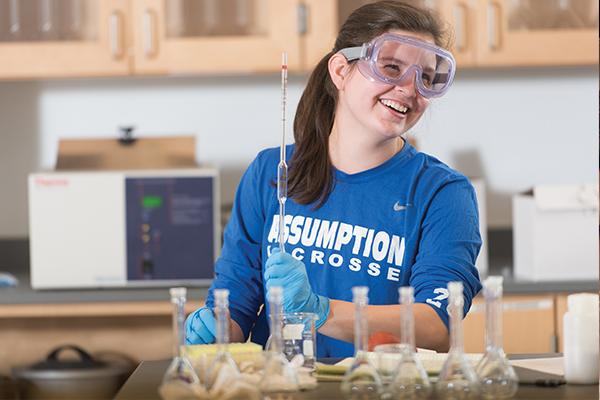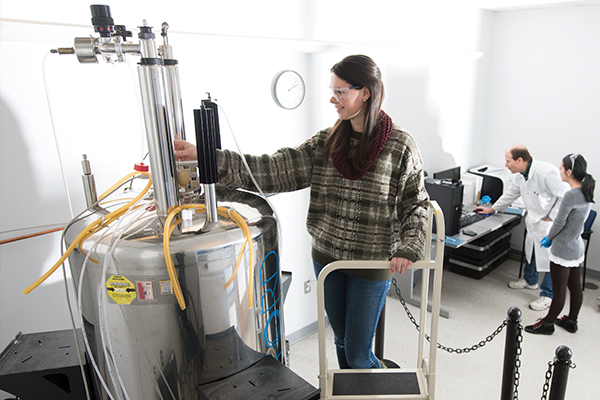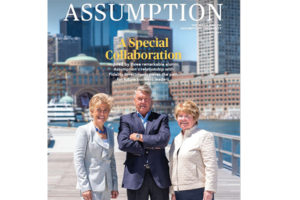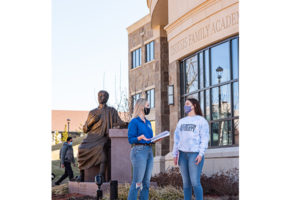
Assistant Professor of Biology Jessica McCready, Ph.D., vividly remembers the first time she went to a professor for help when she was an undergraduate.
“When I told the professor that I hadn’t done well on the last exam and asked if he had any advice, he didn’t even look up from his computer,” she said. “He just kept typing and said I must not have studied properly.”
That class was held in an enormous lecture hall, she added, and was taught in a traditional format, with the professor lecturing at the front of the room. “Even then, I thought there had to be a better way to teach science,” said Prof. McCready.
There is. Today, Assumption professors are transforming science education, with a departure from traditional lectures in favor of adopting active learning techniques like the “flipped classroom.” The result? Assumption students benefit from innovative classroom approaches and working closely with professors who mentor them through hands-on projects and opportunities for laboratory research beginning in their freshman year, effectively preparing them from the first day of classes to pursue professional careers in health, research, and industry.
So what’s a flipped classroom
The “flipped classroom” is an innovative teaching method that focuses on actively engaging students. When it was first developed, this pedagogical model called for professors to have students watch videoed lectures online before class, then come prepared to answer questions and complete assignments.
Prof. McCready uses a modified version of this model. In her anatomy class, for instance, she asks students to complete brief assignments on new material prior to class. “Students then work in groups during class to answer questions as I review the information,” she said. “This encourages them to take ownership of the material.”
Associate Professor of Biology Michele Lemons, Ph.D., also engages students through active learning strategies in her upper-level neuroscience class. Students read about patients who present with certain symptoms, then work in groups to apply their understanding of neuroanatomical pathways and “solve the puzzles,” formulating a diagnosis.
Non-science majors benefit from an active learning approach, too. Prof. Lemons has developed a new class, Matters and Mysteries of Your Brain, that helps students from any discipline use case studies to introduce new neurobiological concepts.
For instance, the first case study centers on a woman who has lost her sense of balance. “It serves as a springboard to dive deeper into the topic of the vestibular system, our sense of balance, and the brain,” said Prof. Lemons. From there, students develop their own classroom experiments to gain a deeper understanding of the neurobiology behind human balance, then research current news stories on the topic, honing their science literacy skills.

Bench time is a good thing
Many professors also encourage students to participate in research projects. “I love working with students in the research lab because it’s so hands-on,” said Prof. Lemons. “These students apply everything at the lab bench that they’re learning in class.”
Thomas Barringer ’19 grew up in Maryland close to the National Zoo in Washington, DC, and became fascinated by animals. In high school, volunteering as a counselor in the zoo’s summer camp program “inspired me to want to be a zookeeper,” he said.
At Assumption, he’s majoring in biology and currently completing an independent research project on cell growth. Laboratory research might not sound useful for a zookeeper, but Barringer discovered its relevance firsthand while working as an animal care intern at a zoo in St. Louis last summer. “The zoo veterinarian did PCR (polymerase chain reaction) tests on monkeys. I knew what they were because I’d done those tests in my cellular and molecular biology labs.”
Bench time at Assumption starts as early as freshman year. Zachary DeLoughery ’12, a triple major in chemistry, biotechnology, and biology with a concentration in neuroscience, logged many hours in Assumption’s Testa Science Center (see sidebar). His research internships – one in organic chemistry and the other working on a research team with Prof. Lemons – were instrumental in preparing him for a career in biomedical science.
“When I started my graduate work at Brown University, I realized that we were taught very advanced laboratory techniques at Assumption,” he said.
When it comes to science, a liberal arts institution is the place to be
When Lauren Brown ’15 toured Assumption, she knew immediately that this was where she needed to be. “People who want a strong education in science seem to shy away from liberal arts institution’s like Assumption,” she said, “but seeing the amazing laboratory research going on here, and realizing that I’d really get to know my professors, made me appreciate this unique setting.”
Brown, who originally set her sights on being a high school biology teacher, graduated with a B.A. in molecular and cellular biology and a minor in secondary education. Today, she is a Clinical Bioinformatics Analyst II at Foundation Medicine in Cambridge, a company that connects patients and physicians to the latest cancer treatments, and she is pursuing an MBA.
Like Brown, Maggie Bara ’14 was interested in becoming a teacher. Then she took an Introduction to Biology class and experienced a “transformative moment.”
“One day, the professor was talking about this metabolic pathway called glycolysis, where your body breaks down sugars,” said Bara, “and she said your body’s cells are doing this right now, while you’re sitting in my classroom. That was the first time I ever thought about how people are doing research and making new discoveries in biology every day.”
Bara eventually became a biology major and conducted a full year of research at Assumption, studying what happens to immune cells during an infection. Today, she is a Ph.D. student at Duke University and conducting lung cancer research.
Part of what makes it possible for Assumption undergraduates to conduct such high-level, hands-on research is the institution’s small class sizes that allow professors time to closely mentor students.
“Assumption students earn authorship on publications in peer-reviewed science journals, and many attend professional scientific meetings where they present their research to an international audience,” said Prof. Lemons. Students also benefit from being at a liberal arts institution, she added, “where we’re dedicated to graduating well-rounded, ethical citizens with great communication skills.”
“Assumption’s message of energy and inspiration is ‘Light the Way,’” Brown reflected, “and I love it. To me, ‘Light the Way’ means learning how to light your own fire. My professors were so passionate and motivated that I couldn’t help but be passionate and motivated, too. Assumption really helps shape what you believe and who you are.”
Research Opportunities Abound at Assumption’s Testa Science Center
The Richard and Janet Testa Science Center, named in honor of Assumption alumnus Richard Testa ’59 and his wife Janet HD ’07, houses the Natural Sciences Department. Noted for its state-of-the-art and artistic elements, the 63,000-square-foot Testa Science Center offers:
• 10 teaching laboratories
• Seven faculty and student research laboratories
• Cutting-edge equipment, including a fluorescent compound microscope, NMR spectrometer, and quantitative PCR machine
• The Brazelton Greenhouse, a rooftop greenhouse for biology and botany studies
• Lounge and study areas
• The Adler Trust Auditorium, a lecture and performance space


